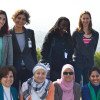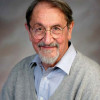News
Lab Hosts 5 Emerging Leaders During TechWomen 2013
TechWomen 2013 brought 76 women from 16 Middle Eastern and African countries to the U.S. in October for a five-week professional mentoring program. TechWomen is an international exchange designed to empower, connect and support women professionals in science, technology, engineering, and mathematics (STEM). This is the third year the Lab has been represented in the program. Read More »
Big Data Hits Beamline
When scientists from around the world visit Dula Parkinson’s microtomography beamline at Lawrence Berkeley National Laboratory’s Advanced Light Source, they all want the same thing: scientifically illuminating X-ray views of matter. Unfortunately, many of them have left with debilitating data overload. Department of Energy scientists like Parkinson are collaborating with computational scientists and mathematicians on data-handling and analysis tools. Read More »
Searching for Cosmic Accelerators via IceCube
New results from IceCube, the neutrino observatory buried at the South Pole, may show the way to locating and identifying cosmic accelerators in our galaxy that are 40 million times more powerful than the Large Hadron Collider at CERN. Read More »
$25.4 Million for Exascale Supercomputer Interconnect Design
The Department of Energy’s (DOE) Office of Science and the National Nuclear Security Administration (NNSA) have awarded $25.4 million in research and development contracts to five leading companies in high-performance computing (HPC) to accelerate the development of next-generation supercomputers. Read More »
Berkeley Lab @ SC13
For the first time, the facilities and capabilities of 15 DOE Labs will be highlighted in a booth program featuring presentations by HPC experts, electronic posters, demos, roundtable discussions and a 3D display. Don't miss these Berkeley Lab experts. Read More »
Turning Greenhouse Gases into Gold
Environmentalists have long lamented the destructive effects of greenhouse gases, with carbon dioxide (CO2) often accused of being the primary instigator of global climate change. As a result, numerous efforts are under way to find ways to prevent, capture and sequester--perhaps even bury--CO2 emissions and reduce their negative effects. But some researchers say CO2 is getting a bad rap. They contend that it represents a virtually unlimited energy resource that can be recycled into… Read More »
New Model of Earth’s Interior Reveals Clues to Hotspot Volcanoes
Using supercomputers at NERSC, scientists have detected previously unknown channels of slow-moving seismic waves in Earth’s upper mantle. This discovery helps to explain how “hotspot volcanoes”—the kind that give birth to island chains like Hawaii and Tahiti—come to exist. Read More »
Computing Sciences Women Honored for STEM Contributions
Kathy Yelick, Associate Laboratory Director for Computing Sciences, and Deborah Agarwal, head of CRD's Advanced Computing for Science Department, were among 15 women honored for contributions to STEM during Berkeley Lab's first "Women@The Lab" event. Read More »
2D monolayers could yield thinnest solar cells ever
New computer simulations have shown how using a different type of material could enable thinner, more lightweight solar panels that provide power densities – watts per kilogram of material – orders of magnitude higher than current technologies. Read More »
NERSC User Martin Karplus Wins Nobel Prize in Chemistry
On Wednesday, the Nobel Prize in Chemistry was awarded to three scientists for pioneering methods in computational chemistry. One of the laureates—Martin Karplus of Harvard University—has been using supercomputers at NERSC since 1998. Read More »







 Instagram
Instagram YouTube
YouTube








